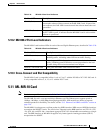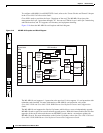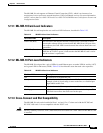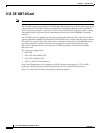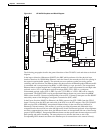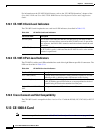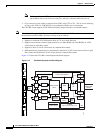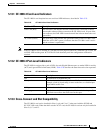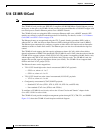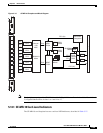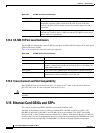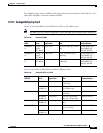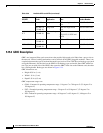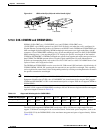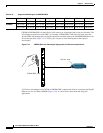
5-33
Cisco ONS 15454 Reference Manual, R8.5.x
78-18106-01
Chapter 5 Ethernet Cards
5.13.1 CE-1000-4 Card-Level Indicators
5.13.1 CE-1000-4 Card-Level Indicators
The CE-1000-4 card faceplate has two card-level LED indicators, described in Table 5-25.
Note If the CE-1000-4 card is inserted in a slot that has been preprovisioned for a different type of card, the
red FAIL LED and the green ACT LED will flash alternately until the configuration mismatch is
resolved.
5.13.2 CE-1000-4 Port-Level Indicators
The CE-1000-4 card provides a pair of LEDs for each Gigabit Ethernet port: an amber LED for activity
(ACT) and a green LED for link status (LINK). Table 5-26 describes the status that each color represents.
5.13.3 Cross-Connect and Slot Compatibility
The CE-1000-4 card can be installed in Slots 1 to 6 and 12 to 17 when used with the XC10G and
XC-VXC-10G cards. When the shelf uses the XCVT card, the CE-1000-4 card can only be installed in
Slots 5, 6, 12, and 13.
Table 5-25 CE-1000-4 Card-Level Indicators
Card-Level LEDs Description
FAIL LED (Red) The red FAIL LED indicates that the card processor is not ready or that a
catastrophic software failure occurred on the CE-1000-4 card. As part of the
boot sequence, the FAIL LED is turned on until the software deems the card
operational.
ACT LED (Green) The green ACT LED provides the operational status of the CE-1000-4 card.
When the ACT LED is green, it indicates that the CE-1000-4 card is active
and the software is operational.
Table 5-26 CE-1000-4 Port-Level Indicators
Port-Level Indicators Description
Off No link exists to the Ethernet port.
Steady amber A link exists to the Ethernet port, but traffic flow is inhibited. For
example, a lack of circuit setup, an error on the line, or a disabled port
might inhibit traffic flow.
Solid green A link exists to the Ethernet port, but no traffic is carried on the port.
Flashing green A link exists to the Ethernet port, and traffic is carried on the port. The
LED flash rate reflects the traffic rate for that port.



